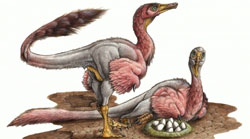Eggs of enigmatic dinosaur discovered

Reconstruction of Bonapartenykus ultimus<br>
What makes the discovery unique are the two eggs preserved near articulated bones of its hindlimb. This is the first time the eggs are found in a close proximity to skeletal remains of an alvarezsaurid dinosaur, says Dr. Martin Kundrát, dinosaur expert from the group of Professor Per Erik Ahlberg at Uppsala University.
The first Argentine-Swedish Dinosaur expedition and collaboration; Fernando Novas, F. Agnolin and J. Powell from Museo Argentino de Ciencias Naturales and Martin Kundrát was performed in December 2010.
The dinosaur represents the latest survivor of its kind from Gondwana, the southern landmass in the Mesozoic Era. The creature belongs to one of the most mysterious groups of dinosaurs, the Alvarezsauridae, and it is one of the largest members, 2.6 m, of the family. It was first discovered by Dr. Powell, but has now been described and named Bonapartenykus ultimus in honor of Dr. José Bonaparte who 1991 discovered the first alvarezsaurid in Patagonia.
– This shows that basal alvarezsaurids persisted in South America until Latest Cretaceous times, says Martin Kundrát.
The two eggs found together with the bones during the expedition might have been inside the oviducts of the Bonapartenykus female when the animal perished. On the other hand numerous eggshell fragments later found show considerable calcite resorption of the inner eggshell layer, which suggest that at least some of the eggs were incubated and contained embryos at an advanced stage of their development.
Martin Kundrát analyzed the eggshells and found that it did not belong to any known category of the eggshell microstructure-based taxonomy. Hence, a new egg-family, the Arraigadoolithidae, was designated and named after the owner of the site where the specimen was discovered, Mr. Alberto Arraigada. Kundrát also made another discovery:
– During inspection of the shell samples using the electron scanning microscopy I observed unusual fossilized objects inside of the pneumatic canal of the eggshells. It turned out to be the first evidence of fungal contamination of dinosaur eggs, he says.
About Alvarezsaurid theropods: These were small (0.5-2.5 m) bipedal feathered dinosaurs known from Asia, North and South America. They had a bird-like skull, tiny teeth-carrying jaws, typical robust but considerably abbreviated forearms, and one of their manual digits that developed massive phalanges including enormous claw.
Media Contact
More Information:
http://www.uu.seAll latest news from the category: Earth Sciences
Earth Sciences (also referred to as Geosciences), which deals with basic issues surrounding our planet, plays a vital role in the area of energy and raw materials supply.
Earth Sciences comprises subjects such as geology, geography, geological informatics, paleontology, mineralogy, petrography, crystallography, geophysics, geodesy, glaciology, cartography, photogrammetry, meteorology and seismology, early-warning systems, earthquake research and polar research.
Newest articles

Webb captures top of iconic horsehead nebula in unprecedented detail
NASA’s James Webb Space Telescope has captured the sharpest infrared images to date of a zoomed-in portion of one of the most distinctive objects in our skies, the Horsehead Nebula….

Cost-effective, high-capacity, and cyclable lithium-ion battery cathodes
Charge-recharge cycling of lithium-superrich iron oxide, a cost-effective and high-capacity cathode for new-generation lithium-ion batteries, can be greatly improved by doping with readily available mineral elements. The energy capacity and…

Novel genetic plant regeneration approach
…without the application of phytohormones. Researchers develop a novel plant regeneration approach by modulating the expression of genes that control plant cell differentiation. For ages now, plants have been the…





















